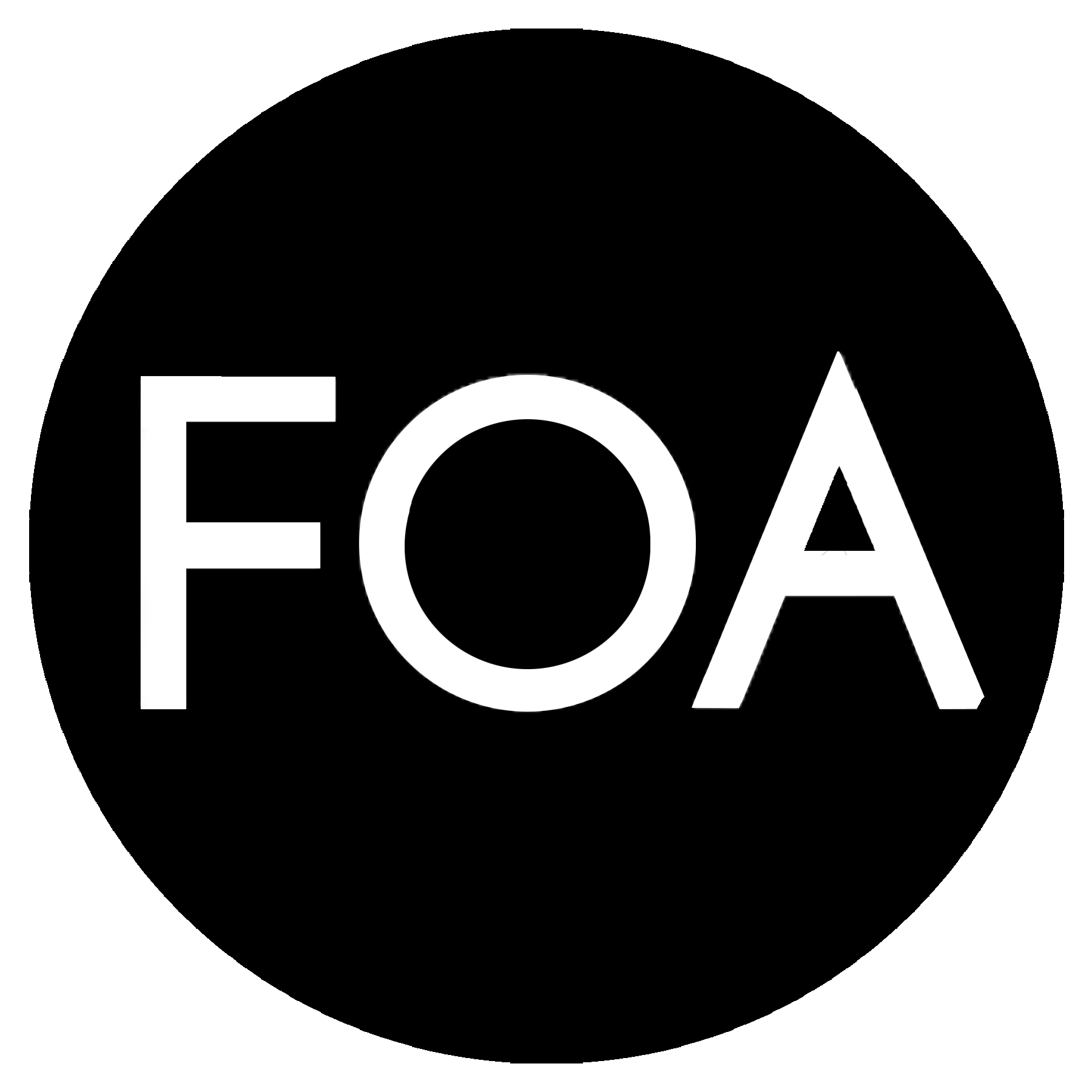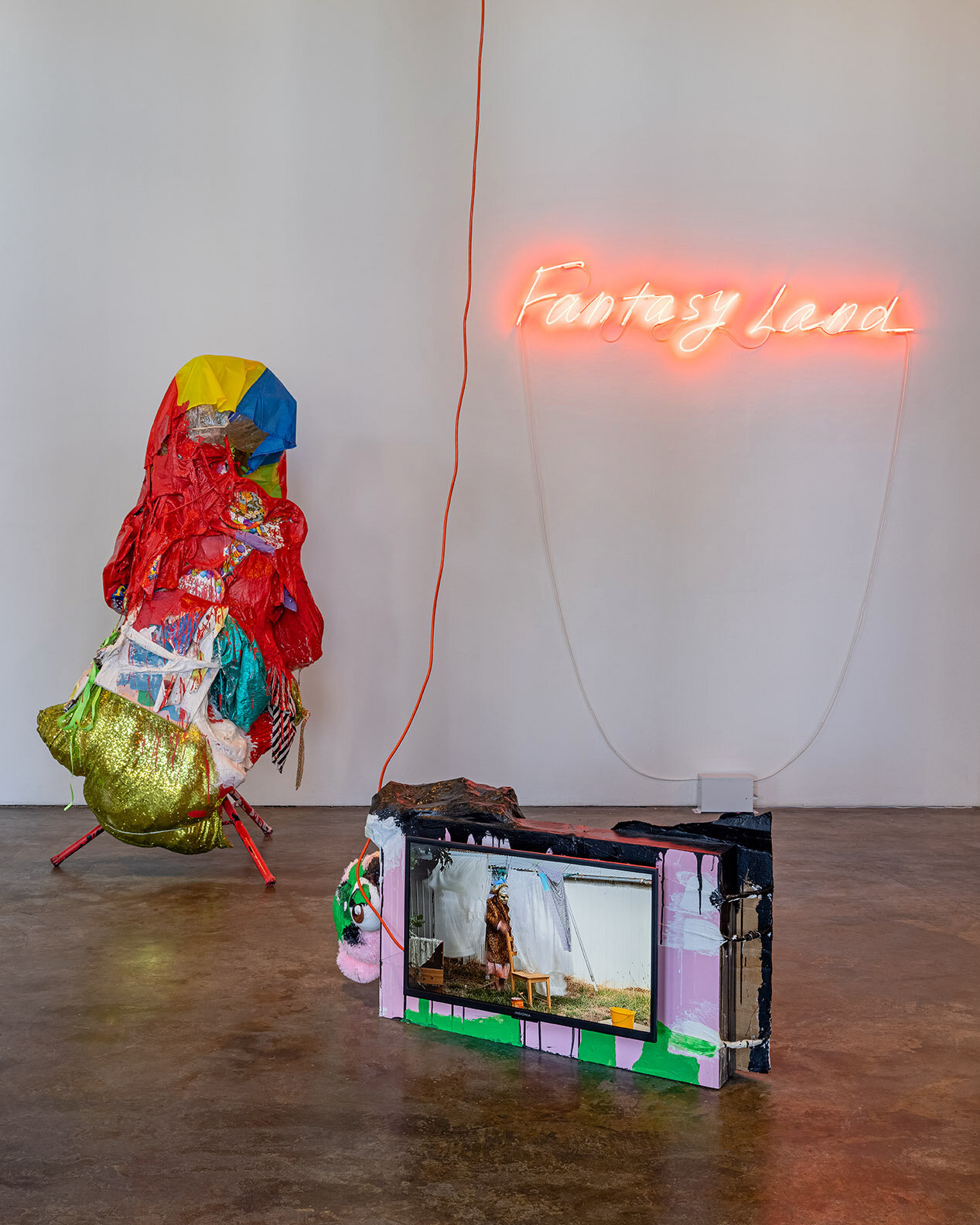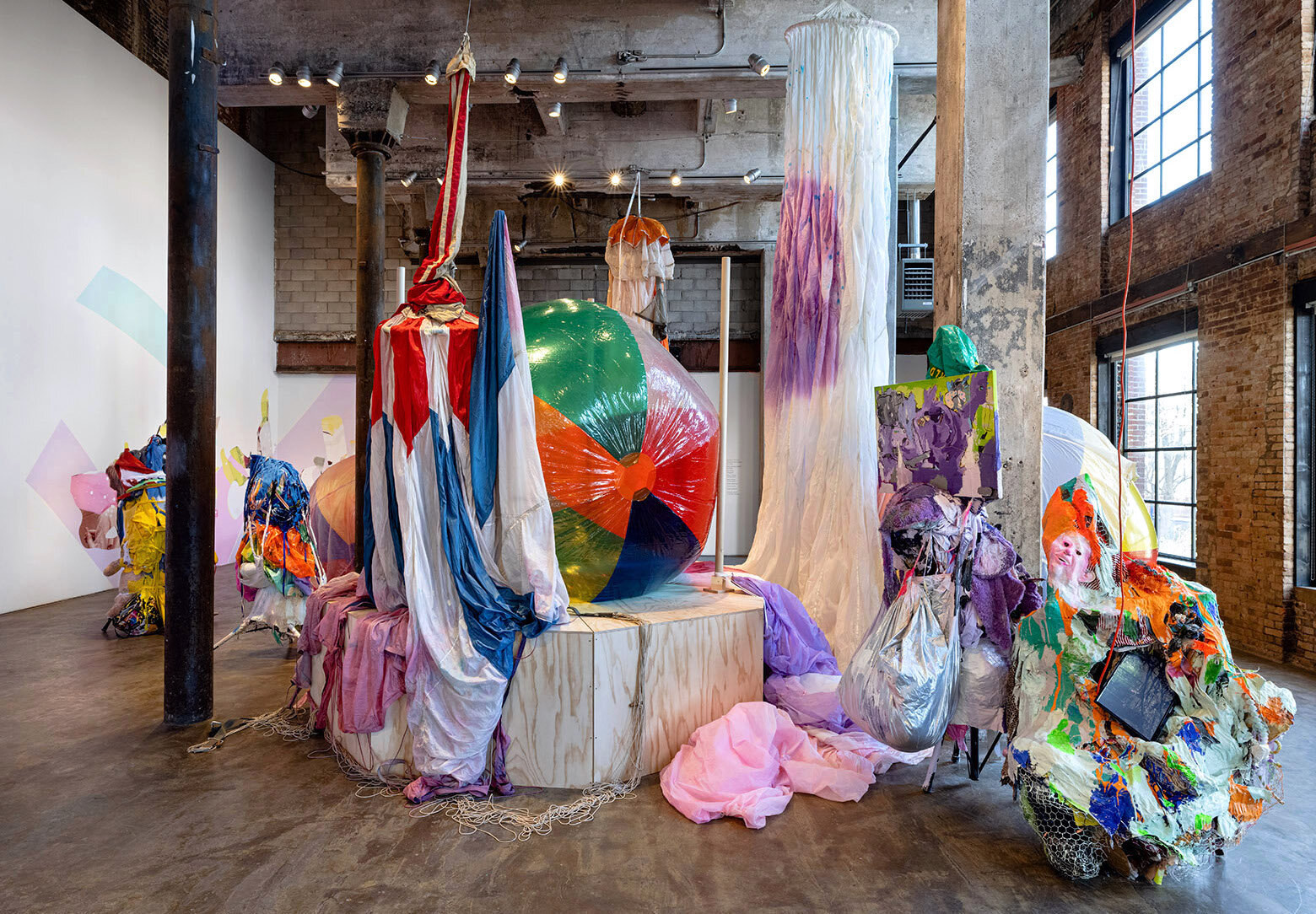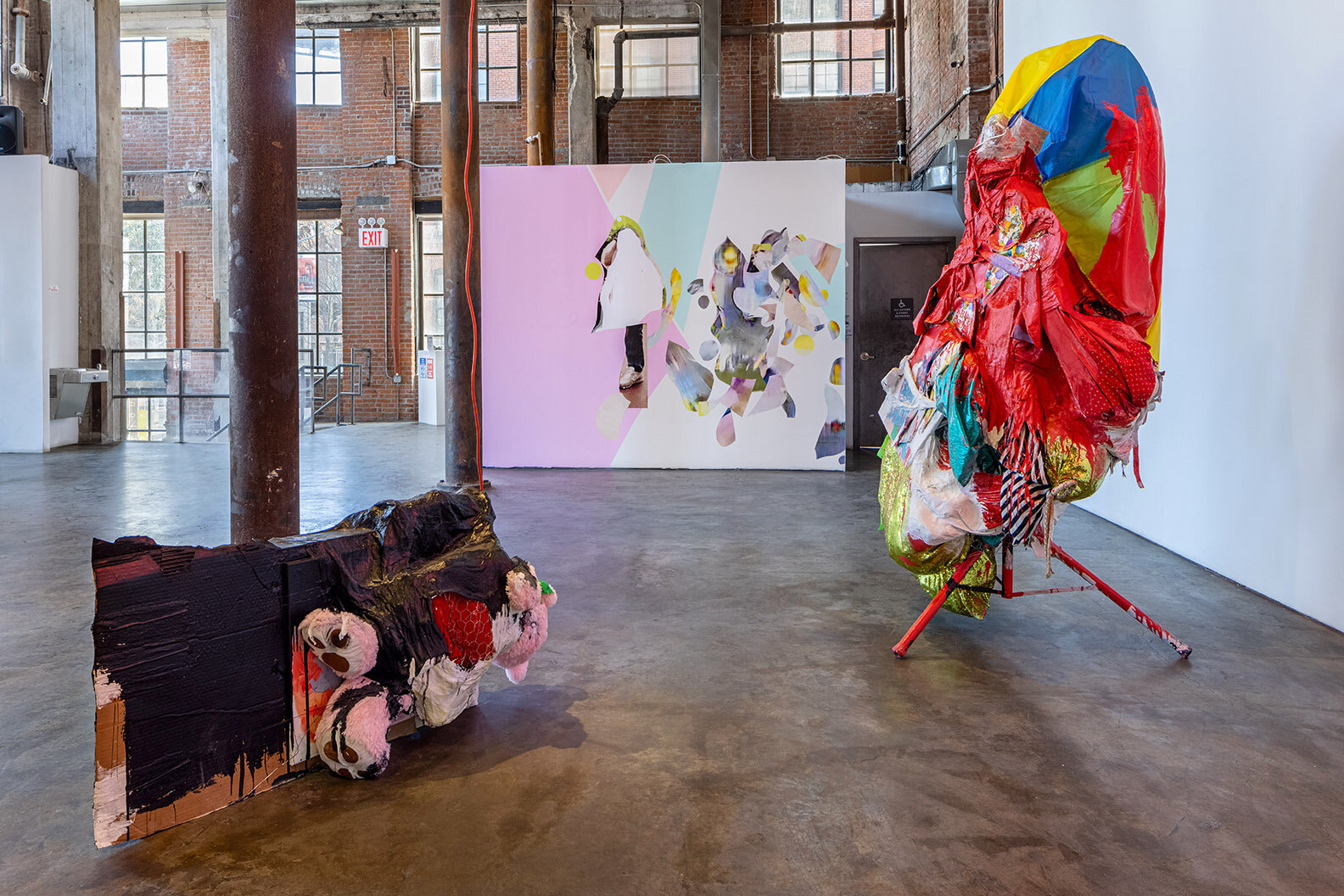Studio Visit: Katya Grokhovsky and Her Ladies Invite You to FANTASYLAND
Katya Grokhovsky
was born in Ukraine, raised in Australia and is based in NYC. She is an artist, independent curator, educator and a Founding Director of The Immigrant Artist Biennial (TIAB). Grokhovsky holds an MFA from the School of the Art Institute of Chicago, a BFA from Victorian College of the Arts, Melbourne University, Australia and a BA (Honors) in Fashion from Royal Melbourne Institute of Technology, Australia.
Image: Katya Grokhovsky, Fantasyland 2021 Image courtesy of Smack Mellon. Photo Etienne Frossard
IN THE STUDIO WITH KATYA GROKHOVSKY
by Anna Mikaela Ekstrand
“Ladies line up!,” artist Katya Grokhovsky announced as we entered one of the studio spaces that she was temporarily working out of at Elizabeth Foundation for the Arts to prepare for her solo-show FANTASYLAND at Smack Mellon. She was referring to her large-scale installations made out of dyed parachutes, and textiles looming and crowding the space, ladies in waiting soon to be installed. Grokhovsky has a maximalist approach, limit-less and boundary breaking, to her practice, oftentimes she will up cycle works, combining previous works or elements adding points of entry disrupting the elevation of permanence and stability in novel ways. In FANTASYLAND this is translated into a physical form through material abundance; using the language of kitsch and through soft sculpture it serves as a visually striking critique of American consumer society and, mainly through the incoorporated video work, an important commentary on female stereotypes.
Having lived in the United States for over ten years, Grokhovsky’s work is influenced by her immigrant experience, moving from the Soviet Union to Australia as a teenager and to the United States via the United Kingdom as an adult. To amplify the multiple voices of immigrant artists she founded “The Immigrant Artist Biennial,” which had its inaugural edition last year. An accomplished artist, FANTASYLAND is Grokhovsky’s ninth and largest solo show and is open through May 2nd, 2021.
We sat down with Grokhovsky to speak about how she navigates shifting studio spaces, her various roles in the art world, and feminist processes and practice.
Anna Mikaela Ekstrand: You work across multiple mediums with vastly different requirements on your studio space, ranging from sculptures, video works, performances in plein air or at institutions, to digital and analog painting and drawing, and large-scale installations and fiber works. How does the size of your studio impact your practice, or vice versa?
Katya Grokhovsky: Each project is different, and after almost a decade of maneuvering and practicing through residencies and subsidized studios in the U.S, I have devised a particular system of production, which depends on recycling and reassembling of a lot of my past works as well as mobility and size expansion and reduction. The process is designed to not depend on the size of a particular studio I have at any given moment, in order to free up my ideas and not to hinder my work. However, I would say funding more than anything else tends to impact my practice, as of course the more financial freedom a project affords me, the more space, materials and facilities I am able to have access to.
AME: Where and how do you develop and rehearse your performance work?
KG: I consider my performance work as another medium I utilize in my practice, akin to sculpture or painting, so it all happens in my studio. Usually, my performance works are connected to my installations and grow out of sculptures or drawings, as characters, who inhabit my worlds. I usually do not rehearse any of my work, instead I write, conceptualize, make costumes, sound and video, design personas, sets and have conversations with performers, if I have other people participating. More often now, I workshop the work in a variety of innovative formats, to keep it fresh, alive and maintain a sense of fear of failure, which is important to me as a core in my live performance action.
AME: Currently FANTASYLAND is on view at Smack Mellon, it marks your ninth solo exhibition and is also your largest exhibition to date. Visiting the two studio spaces you were occupying to prepare for the show was incredible. To paint a picture for our readers – you were using buckets of dye on the floor to dye parts of parachutes hanging from the ceiling in one and a collection of sculptures with found objects, mixed with plaster, paint and fabric in another. Most works you could not see fully, until they were installed. How do you map out this type of exhibition that only truly comes to life in the exhibition space?
KG: I try to get to know the space of the exhibition first, in order to understand the site and create a dialogue with it through my work. I am always interested in creating an experience in my installations, leading the viewer into a world, with a variety of immersive elements. Once I have a vision, I map it out digitally and create zones of making. Then I get to work, outsourcing some of the production, collecting and assembling materials for studio works, etc. Larger installations often take a long time and are made in parts, sometimes in different spaces and with and by other people.
AME: The time-based and site-specific considerations of performance makes it unstable in comparison to a painting for example, which ideally remains unchanged. A painting lives on a wall or in a storage space, while a performance exists solely in the imagination and memory of its viewers, or lives on in a different form in a recording. I consider the way you upcycle or recycle your sculpture and installations to create new works as making use of processes normally tied to performance practice. Is there a connection between the two?
KG: For me, my installations and sculptures are paintings in space and also performances of gesture, repetition and endurance. They are quite visceral and physical and require a lot of effort and material reinvention. My sculptures specifically tend to fail often, through sheer gravity and physics, as I like to mash up materials which are normally not meant to be together. That kind of practice is quite bodily and reflects a type of dangerous dance, a choreography of movement in space, especially once I am on site, installing. I sweat, I move, and I hurt myself making my work. The magic of Chaos is in my nature and it is a co-dependent relationship.
AME: FANTASYLAND is about the United States, so excess, materialism, and capitalism are core subjects. How does your process of recycling and reassembling comment on these cultural exigencies?
KG: As an artist, who loves to work with her hands and collects materials, I am guilty of consumerism and over production myself, so I try to upcycle and reuse what I acquire and make and so on. It is a process of consistent reinvention as well as tough decision making, when it comes to discarding of some of the work and/or material. It can be both liberating and terrifying and I enjoy the push and pull of accumulating and letting go. I utilize mostly used objects, except for some novelty items, such as beach balls and giant plush toys, which signify unnecessary overconsumption. Those particular objects get re-used a lot in my work, and have new lives in most of my recent exhibitions.
AME: You received your permanent residency recently, after a lengthy and arduous process, of course. Did this shift the way you think about your practice in the U.S at all?
KG: I think it has, more than I imagined it would. I am slowly relaxing into the home that I built for my art and life in this country, but the tension of migrating for the last ten years left its’ undeniable mark of fear. I can only now stand back and reflect, without racing to fulfill artist visa requirements and watching the clock ticking over my head. It is time to close some chapters and say no to some projects and organizations, who do not value my time and labor enough, without being afraid I am not doing all I can to stay here. I am open to new paths, growth and evolution, as well as building a legacy and sustaining my practice and future here.
AME: You are also a curator. How do you separate your artistic and curatorial practice? Do you curate yourself into shows? Why is it important for you to maintain a curatorial and artistic practice?
KG: I consider my curatorial practice a part of my artistic self in general, but it is second to my art. I curate once a year or every two years now. I mostly curate artists, whose voices I believe should be amplified and whose work I’d like to see more of out there in the world. Curatorial work takes me out of my own space and into the world, letting me into other artists’ studios and visions. It has been very important for me to do that, to collaborate, explore, support and give back. I no longer curate myself into exhibitions, as I cannot fully take on a professional role of a curator when I do that and I prefer to separate my two personas to maintain a critical eye and distance.
AME: You worked with Martha Wilson, Wangechi Muttu, Barbara Hammer, and other feminist artists, how have their processes of preserving and building their own archive and legacy influenced the way that you run your studio?
KG: Early in my practice, I learned a great deal by assisting other artists, especially women. I observed their daily studio routines and going ons and even though each had a unique approach, I think what they all have in common, and what I mostly took away from each can be summed up by these words: perseverance, resilience, ambition, persistence. All have inspired me to keep at it, in the face of rejection and ignorance, and claim my space, raise my voice, build my own legacy, fight for survival and recognition, as nobody else will. I am now entering a next phase of my practice, where I’d like to gain suitable commercial gallery representation and build my market etc. I know where I am headed and it is a lifelong marathon.
AME: If anything were possible what would your dream studio look like and where would it be located?
KG: In my book, anything is possible! In the blue-sky world, I’d like to have two large scale studio buildings, one in NYC, where multiple floors are dedicated to a variety of mediums and processes such as: a painting floor, digital and shooting studio lab floor, sculpture facilities, performance floor, staging installation space, gallery floor, etc and a large scale production studio Upstate, with a residency program for other artists. I have seen it before, and I can do it too! Dreams do come true, don’t they?








